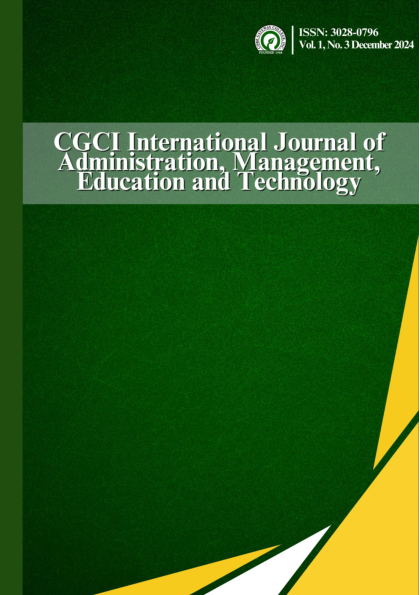VOICES OF INCLUSION: UNRAVELING THE REALITIES AND CHALLENGES OF WORKING WITH CHILDREN WITH SPECIAL NEEDS
DOI:
https://doi.org/10.70059/hjfhmk29Keywords:
Challenges, inclusive education, special education teachers, support systemsAbstract
This qualitative study explored the experiences, challenges, and roles of professionals working with children with special needs in
inclusive educational settings. The study used A total sampling of nine individuals, comprising two male and seven female teachers, employed at San Jose West Central School and San Jose National High School. The study found that special education teachers often assumed dual roles as lecturers and nurturers, providing instruction and emotional support to their students. Skill-building and the availability of numerous learning resources were also highlighted as essential aspects of their work. Despite their dedication, special education teachers faced significant challenges. These included the teacher-student ratio and a lack of facilities, which hindered the delivery of tailored support and quality education. However, the study emphasized special education teachers' unwavering dedication and resilience in their efforts to provide quality care and support to children with special needs. Supporting their well being by addressing their needs for rest, mental health support, and collaboration with local government units was identified as crucial for
maintaining their effectiveness and promoting inclusive practices. The findings of this study contribute to a better understanding of the realities faced by professionals in inclusive educational settings and underscore the importance of ongoing support systems, training, and resources. By recognizing and addressing the needs of special education teachers, the education system can create inclusive and supportive learning environments that benefit teachers and students with special needs.
References
Ahmed Aldeeb, H. M. (2018). Impact of Accumulated Teaching Experience on Supporting Learners In Higher Education: A Case Study From Bahrain. Social Science Learning Education Journal, 3(11), https://doi.org/10.15520/sslej.v3i11.2351 24–28.
Ajoc, I. G. (2019). The Special Education Program (SPED) in the Province of Surigao del Sur. SMCC Teacher Education Journal, 1. http://orcid.org/0000-0002-7675-8278
Callahan, K., Henson, R. K., & Cowan, A. K. (2008). Social validation of evidence-based practices in autism by parents, teachers, and administrators. Journal of Autism and Developmental Disorders, pp. 38, 678–692. https://doi.org/10.1007/s10803007-0434-9
Catoto, J.S., & Mantawil, B.A. (2023). For the Love of Teaching: The Chronicles of Teachers Handling Students with Special Educational Needs. Journal of Curriculum and Teaching. https://doi.org/10.5430/jct.v12n1p63
Eichinger, J. (2000). Job Stress and Satisfaction Among Special Education Teachers: Effects of gender and social role orientation. International Journal of Disability, Development and Education, 47(4), 397–412. doi:10.1080/713671153
Finkelstein, S., Sharma, U., & Furlonger, B. (2019). The inclusive practices of classroom teachers: a scoping review and thematic analysis. International Journal of Inclusive Education, 25:6, 735-762, DOI: 10.1080/13603116.2019.1572232
Gaille, L. (2019, May 20). 15 Pros and Cons of an Inclusion Classroom. Retrieved from https://vittana.org/15-pros-and-cons-of-aninclusion-classroom
Hamama, L., Ronen, T., Shachar, K., & Rosenbaum, M. (2012). Links Between Stress, Positive and Negative Affect, and Life Satisfaction Among Teachers in Special Education Schools. Journal of Happiness Studies, doi:10.1007/s10902-012-9352-4 14(3), 731–751.
Hoover, J. J., & Patton, J. R. (2008). The Role of Special Educators in a Multitiered Instructional System. Intervention in School and
Clinic, 43(4), 195–202. doi:10.1177/1053451207310345
Inciong, T., & Quijano, Y. (2004). Inclusion of Children with Disabilities: The Philippines Experience. Asia Pacific Journal of Education, 24:2, 173-191, DOI: 10.1080/02188791.2004.10600208
Jain, N. & Goswami, V. (2014). Is Optimism A Key Factor For Role Performance of Teachers Working with Special Students form https://www.semanticscholar.org/paper/Is-Optimism-A-KeyFactor-For-Role-Performance-of-Jain Goswami/64e5d7e39611349368e8348500b3c3a23af2874c.
Lazarus, L. (2006). Occupational stress, negative affectivity and physical health in special and general education teachers in Greece. British Journal of Special Education, 33(4), 204–209. doi:10.1111/j.1467-8578.2006.00440.x
Little, M., & Kobak, R. (2003). Emotional Security With Teachers and Children’s Stress Reactivity: A Comparison of Special Education and Regular-Education Classrooms. Journal of Clinical Child & Adolescent Psychology, 32(1), 127–138. doi:10.1207/s15374424jccp3201_12
Llego, M. A. (2022, August 25). Inclusive Education in the Philippines. TeacherPH. Retrieved August 25, 2022, from https://www.teacherph.com/inclusive-education-philippines/
Mackenzie, S. (2011). I cannot imagine doing anything else: why do teachers of children with SEN remain in the profession? Resilience, rewards, and realism over time. Journal of Research in Special Educational Needs, 12(3), 151–161. doi:10.1111/j.1471-3802.2011.01221.x
Mu, K., Brown, T., Peyton, C. G., Rodger, S., Huang, Y.-H., Wu, C.-Y., Hong, C. S. (2010). Occupational therapy students’ attitudes towards inclusion education in Australia, United Kingdom, United States and Taiwan. Occupational Therapy International, 17(1), 40–52. doi:10.1002/oti.285
Niro, A. I. & Petilla, J. L. (2019). Stakeholder Engagement To Implement Projects of Specia; Education Centers in Region 1, Department of Education, Philippines. Proceeding of the International Conference on Special Education, 3, 44-55
Peña, K. D. (2023, September 22). Zero budget for special education in 2023 makes SPED law ‘meaningless’ | Inquirer News. INQUIRER.net. https://newsinfo.inquirer.net/1674980/zerobudget-for-special-education-in-2023-makes-sped-law
meaningless#:~:text=The%20DepEd%20said%20the%20%E 2%80%9Cideal,teacher%20ratio%20is%2031%3A1.
Republic Act No. 11650. (2022, March 11). Instituting a Policy of Inclusion and Services for Learners with Disabilities in Support of Inclusive Education Act 2022. https://www.officialgazette.gov.ph/downloads/2022/03mar/20220311-RA-11650.pdf
Special Education Teachers: Roles and Responsibilities. (n.d.). https://www.parallellearning.com/post/special-educationteachers-roles-and-responsibilities#roles-and-responsibilitiesof-special-education-teachers
Schwab, S., & Alnahdi, G. H. (2020). Do they practice what they preach? Factors associated with teacher’s use of inclusive teaching practices among in-service teachers. Journal of Research in Special Educational Needs, 20(4), 321-330, https://doi.org/10.1111/1471-3802.12492
Strogilos, V., Nikolaraizi, M., & Tragoulia, E. (2012). Experiences among beginning special education teachers in general education settings: the influence of school culture. European Journal of Special Needs Education, 27(2), 185–199. doi:10.1080/08856257.2011.645588
Walker, S., & Berthelsen, D. (2008). Children with autistic spectrum disorder in early childhood education programs: A social constructivist perspective on inclusion. International Journal of Early Childhood, 40(1), 33–51. doi:10.1007/bf03168362
Wasburn-Moses, L. (2005). Roles and Responsibilities of Secondary Special Education Teachers in an Age of Reform. Remedial and Special Education,
doi:10.1177/07419325050260030301 26(3), 151–158.
Yasin, M. H. M., Toran, H., Tahar, M. M., & Bari, S. (2010). Special Education Classroom Infrastructure: Teacher’s Views. Procedia - Social and Behavioral Sciences, 7, 601–604. doi:10.1016/j.sbspro.2010.10.081





